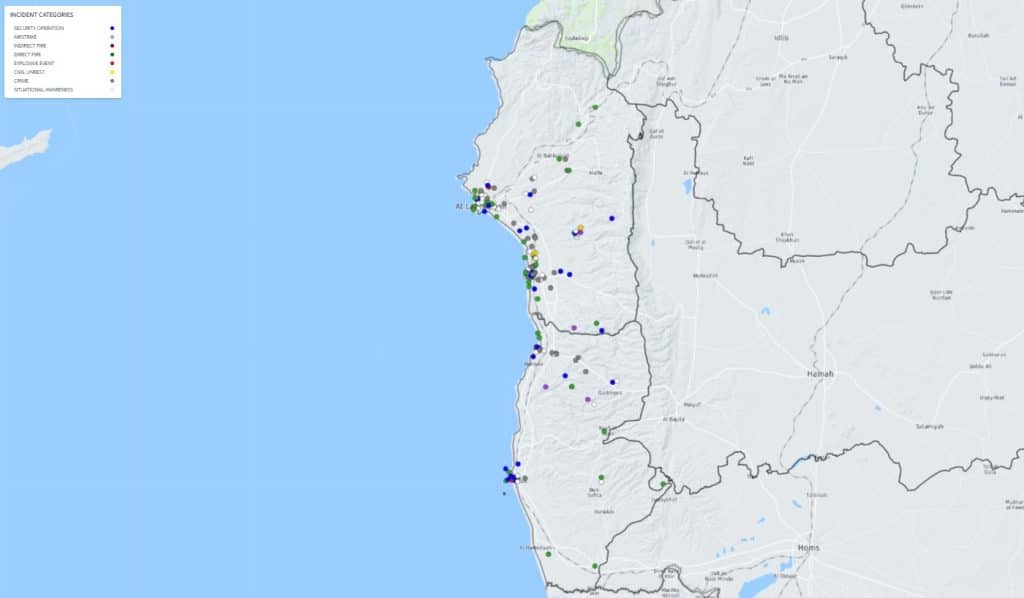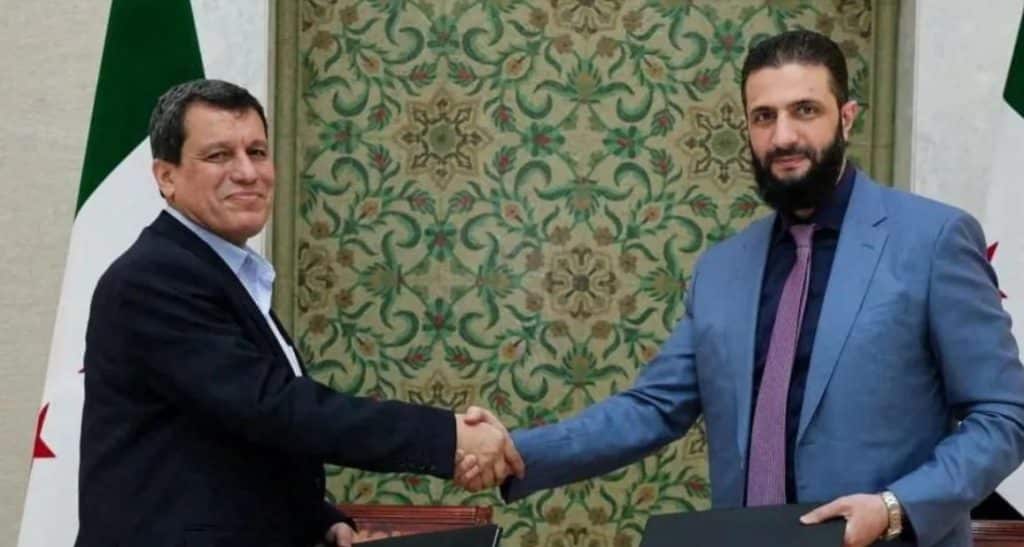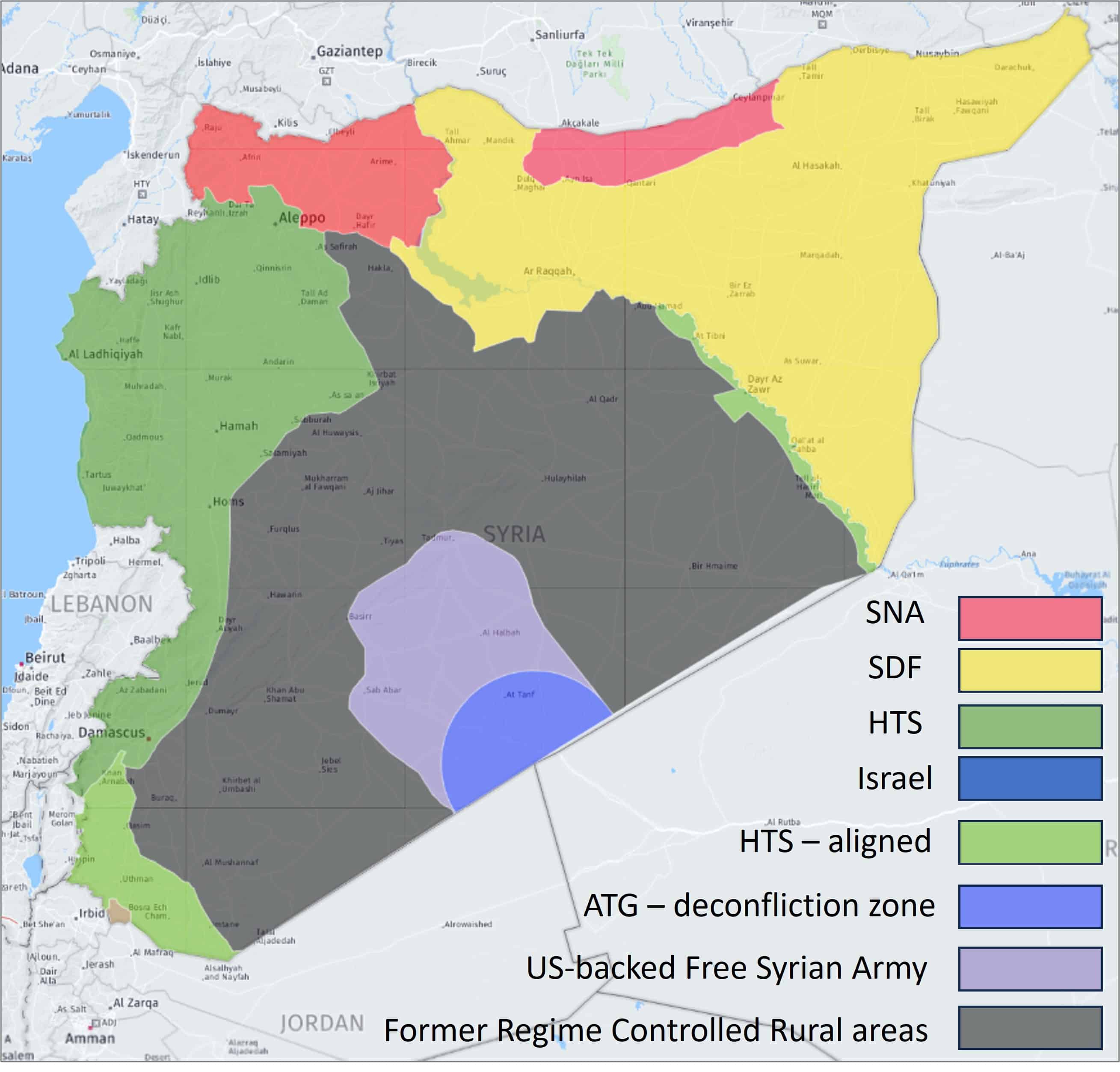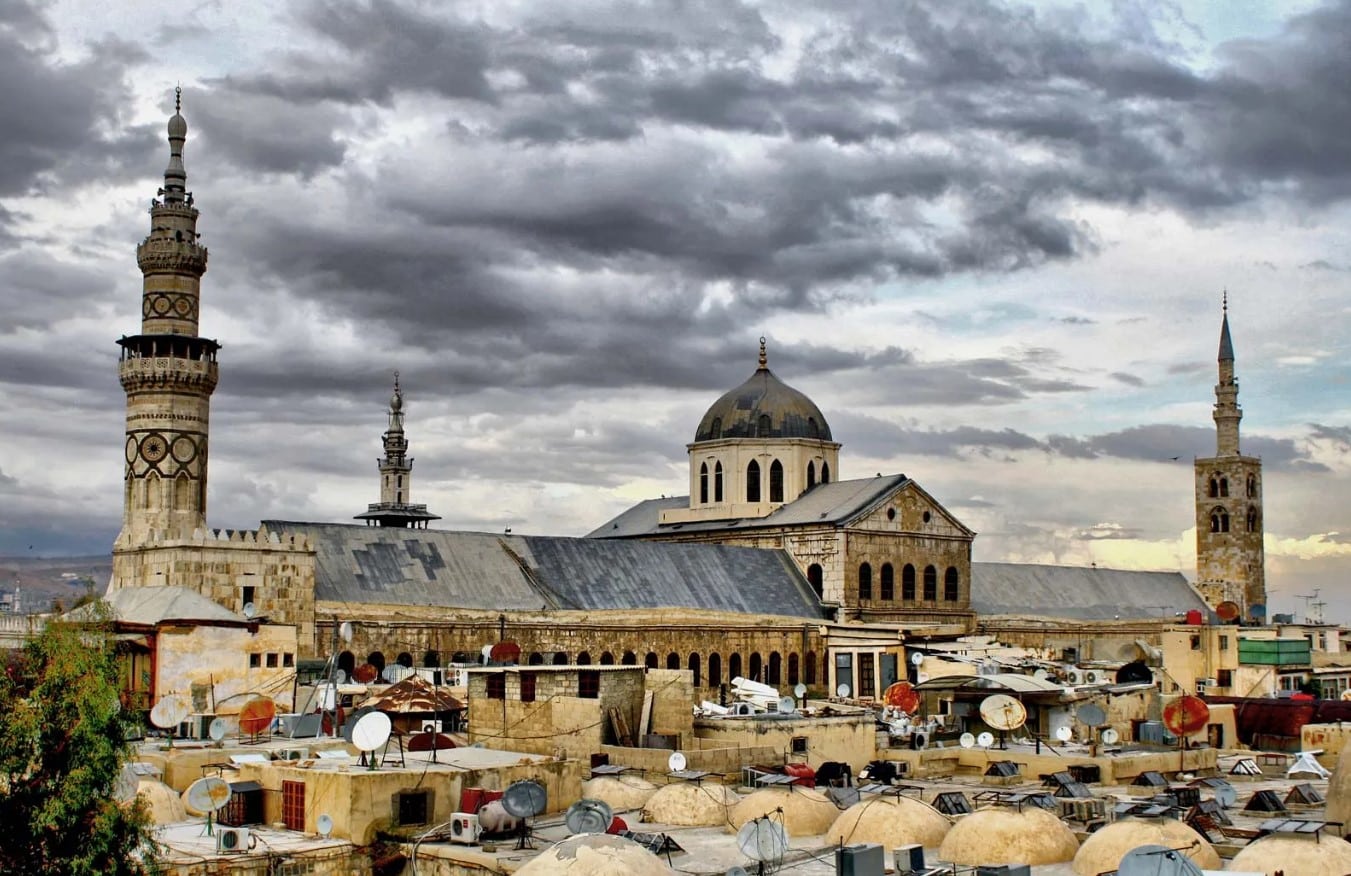Weekly Incident Map
Dear subscriber. Welcome to the Syria Weekly Report – a brand-new reporting service launched by Talos that provides high-quality information and analysis on Syria. The report is focused on broader strategic and political developments in the country, as well as Syria’s relations to regional stakeholders and surrounding countries. The report is disseminated every wednesday and is complemented by a daily report.
The service will be provided for our existing subscribers for free for a limited time period and then offered as a separate, stand-alone product outside your regular subscription. For inquiries regarding prices for a subscription, or the availability of bespoke reporting on Syria – including in-depth reports, risk assessments and incident data – please email [email protected]. Please also contact us if you are interested in transportation or other security services in Syria. In the meantime, please enjoy this complimentary service.
Executive Summary
-
Escalation in coastal region leaves more than thousand casualties
-
Ministry of Defence declares control but long-term questions remain
-
International community reacts strongly to civilian deaths
-
Government blames foreign elements and downplays violence
-
SDF and interim government reach landmark agreement on integration
-
Deal likely influenced by PKK ceasefire and hostilities in the west
Escalation in western coastal region leaves more than thousand casualties
The week was dominated by the significant escalation in hostilities in the coastal provinces of Latakia and Tartous between 6-10 March which witnessed some of the worst and deadliest violence since the start of the Syrian conflict. With more than a thousand killed, including civilians and security forces, and thousands of others injured, the escalation is by far the most significant hostilities to affect Syria since the fall of the Assad regime and has understandably raised serious concerns about the post-conflict situation following months of relative calm and stability.
As discussed in our full report (click here), the violence began when former regime remnants targeted a security patrol in the Jableh area of Latakia province, prompting the HTS to initiate a security campaign in response that set off a series of clashes that escalated over the following days into neighboring Tartous province. To recall, the Latakia province was a stronghold of the former government and remnant factions have remained active in the area even after the fall of the government. The situation escalated rapidly from localized clashes to resemble a more organized and coordinated insurgent uprising by regime remnants who managed to seize control and capture villages in both Latakia and Tartous provinces.

Clashes in Latakia and Tartous province – see interactive map here
By 7 March, the Syrian Resistance – comprising a loose coalition of former Assad loyalists – claimed to have seized control over numerous villages near Jabal al-Alawiyin and expanded operations into the Tartous province as well as some areas in western Homs. In response, the government security forces deployed additional reinforcements to the affected areas, imposed curfews, and announced the launch of major counterinsurgency campaigns in both provinces, with major sweeping offensives involving tanks and armored vehicles as well as air support conducted over 7-9 March.
More ominously, the security operations coincided with reports of large-scale civilian casualties targeting the predominantly Alawite communities affected by the clashes. Reports of mass executions, sectarian attacks, and brutal reprisals were widely and consistently documented through footage published online, as the violence escalated on a communal and sectarian level. Villages such as Qabu al-Awamiya and Shir reportedly underwent mass killings, while Baniyas witnessed one of the deadliest incidents, where over 80 Alawite civilians were reportedly executed.
Elsewhere, large-scale demonstrations broke out to condemn the violence, with large gatherings gathered in Tartous and Latakia City, heeding calls from the Alawite Council to rally in defense of Jableh against HTS. Protesters marched toward governorate buildings before being met with live gunfire from security forces, meant to disperse crowds. In contrast, Sunni-majority neighborhoods in Latakia witnessed demonstrations in support of HTS, reflecting the deep sectarian and political divisions fueling the conflict. While reliable casualty figures remain elusive, the Syrian Observatory for Human Rights estimates that some 973 civilians were killed while other, more conservative sources claim approximately 600 dead. The number of security forces killed likewise ranges between 200-350 while the number of insurgent forces killed is estimated at around 250.
Ministry of Defence declares control but long-term questions remain
On 10 March, the Ministry of Defense claimed to have restored control in the affected areas and declared an end to the military operation against former regime remnants, with life “returning to normal” as per a statement by a spokesperson. Despite this, localized acts of hostilities, clashes and security operations continued to be reported on that day – indicating that remnant elements remained active despite the announcement. The security forces have also set up a large number of checkpoints in the affected areas and continued to deploy security forces in an effort to maintain stability. As of 11 March, the hostilities have certainly been reduced but the outlook for a sudden flare-up in violence should not be discounted and the situation remains highly volatile. Communal tensions are likewise assessed as elevated, with the potential for demonstrations, local violence and reprisal actions assessed as elevated.
The long-term effect of current security measures also remains to be seen, as remnant elements are still assessed to remain active and questions are raised as to the efficiency of current counter-insurgency efforts. The violence this week represented not only the worst violence seen since the fall of the Assad regime but marked some of the deadliest hostilities seen in the entire civil war. The level of coordination and capabilities displayed by the so-called Syrian Resistance defied previous assessments of their strength based on what until 6 March comprised mostly localized incidents and hit-and-run attacks. By contrast, the action by former regime loyalists this week displayed capabilities to significantly challenge the HTS inside Alawite areas, while the associated escalation in sectarian violence illustrated the persistence of deep-seated political grievances.
These factors suggest that conditions exist for a continued insurgency in the West that will likely require a combination of both extensive security force measures – including the permanent deployment of security forces and intelligence gathering assets – and political measures to address underlying grievances. So far, the government’s response has primarily involved the deployment of checkpoints and security deployments, yet it remains to be seen if the interim government will also put in place engagement efforts to address social grievances.
International community reacts strongly to civilian deaths
The reactions from regional stakeholders to the violence this week were understandably significant, with Western leaders widely condemning the violence against civilians. That said, the reactions were in part shaped by, and reflect, the diverse approaches to the HTS-led government that have characterized the West’s engagement since the fall of the Assad regime. The EU External Action released a statement on 8 March condemning the “recent attacks, reportedly by pro-Assad elements, on interim government forces and all violence against civilians.” Similarly, most European countries, including France and Germany, all condemned the violence but without attributing blame on any one group. By contrast, the US State Department condemned the “Islamist terrorists, including foreign jihadis, that murdered people in western Syria in recent days,” while expressing solidarity with Syria’s “Christian, Druze, Alawite, and Kurdish communities.” The contrasting rhetoric highlights existing differences in their approach, and underscores the US’ cautious and skeptical approach to the HTS-led government.
The reactions in the region were also shaped by existing allegiances and reflected the positions of various stakeholders towards the new government. The GCC states, including Saudi Arabia and Qatar, were quick to condemn the violence but stressed the importance of respecting Syria’s sovereignty and notably omitted any references to violence committed against Alawite or minority groups. Similar rhetoric was expressed by Turkey who expressed support for the government and condemned efforts to destabilize Syria.
In a meeting in Amman on 9 March, attended by the Foreign Ministers of Jordan, Iraq, Turkey and Syria, a joint statement likewise stressed the need to preserve sovereignty and stability but appeared to downplay the escalation in the west by omitting direct references to the instability. The meeting also called for the lifting of international sanctions on the current government – indicating that normalization efforts with the new government remain essentially unaffected by the violence.
Government blames foreign elements and downplays violence
The regional outlier was Iran whose foreign ministry condemned attacks against minorities. The Iranian statement also rejected accusations, implicitly made by the interim government and promoted on social media, that Iran was involved in supporting the insurgency in the West. In a speech on 9 March, President al-Sharaa attributed the violence to “foreign remnants” and “foreign parties behind them” – an implicit but assessed reference to Iran, and possibly Russia, given their long-standing support for the Assad government. The rhetoric by al-Sharaa formed part of a broader government effort to blame foreign elements for the violence, rather than domestic and intercommunal tensions since the latter would undermine perceptions of a peaceful and stable transition.
The government’s response has also been characterized in part by downplaying the extent and scale of the violence, and in particular of intercommunal tensions. The Ministry of Information blamed the circulation of video footage detailing atrocities on “misinformation” and accused foreign elements of spreading propaganda. The ministry also criticized Western media outlets for promoting false narratives and urged all media to rely on official sources for information. In his speech on 9 March, President al-Sharaa also announced the formation of an investigative committee, tasked with reviewing the events this week and reporting their findings to the government within 30 days. The committee forms part of an assessed effort by the government to heed international calls for accountability and to project an image of a functioning judiciary in light of the events.
Regardless, the escalation this week forms a significant setback for the interim government and undermines perceptions of a peaceful and stable transition that has been such an essential element of the government’s credibility so far. More broadly, the hostilities have raised concerns over the outbreak of a new civil war and are set to raise questions about the HTS’s capability to maintain law and order given its relatively small size and given the underlying, complex ethno-sectarian dynamics that still prevail in the country despite the relative calm witnessed in recent months. The subsequent de-escalation witnessed on 10 and 11 March makes such worst-case predictions appear remote, but the events this week serve as a reminder of the underlying volatility and the associated risk of sudden shifts in security dynamics.
Although Western stakeholders appear reluctant to directly blame the government – and appear to reserve judgment with respect to the violence affecting Alawite civilians – the government’s response may also shape engagements with the West over the coming weeks and months. The EU has consistently conditioned the lifting of sanctions on the government on a peaceful and inclusive transition, and it remains to be seen if the latest escalation will change the calculus in Brussels. Meanwhile, the US’ reaction this week certainly downplays any expectations of a normalization effort by Washington and forms a setback for the interim government’s attempt to have US-led sanctions lifted.
SDF and interim government reach landmark agreement on integration
In a separate but related development, the Syrian Democratic Forces (SDF) and the interim government reached an agreement on 10 March to integrate the SDF into the new Syrian Army. The agreement also stipulated the integration of all civilian institutions in the northeast Syrian under the administration of the Syrian state. A statement by the Syrian Presidency said this includes border crossings, the [Qamishli International] Airport, and oil and gas fields”. The deal further pledged to “guarantee the rights of all Syrians to representation and participation in the political process and in all state, institutions based on competence, regardless of their religious and ethnic backgrounds.” The presidency added that the agreement will be implemented “no later than this year”.

SDF Commander Mazloum Abdi and President al-Sharaa
The reactions to the agreement were broadly positive with Kurdish factions in Syria and Iraq, praising the deal as a step towards preserving peace and ensuring the rights of Kurdish minorities. In the northeast, people took to the streets to celebrate, with local sources reporting a widespread feeling of relief following previous concerns that a failure to reach an agreement would translate into a new conflict front between the SDF and the HTS. Regional countries also welcomed the agreement, with congratulatory statements released by Qatar, Saudi Arabia and other GCC states. On 11 March, Turkey’s President Recep Tayyip Erdogan also praised the agreement, following initial silence, and described it as contributing to peace and stability.
The agreement came as a surprise following previous disagreements between the SDF and the HTS over the issue of integration. To recall, the SDF has consistently rejected calls to integrate on an individual basis and has insisted that it retains autonomy as an independent military bloc as a condition for merging with the new Ministry of Defence. Politically, the SDF and its political wing, the SDC, have also advocated a centralized, federal structure that would ensure a level of political and administrative autonomy. The seven-point agreement announced on 10 March contained few details on how the integration will work in practice, and it is currently unclear which side opted to concede their previous negotiating position. The pledge that the agreement will be implemented “no later than this year”, implicitly suggests that practical details still remain to be resolved and may still be subject to negotiations, with associated dynamics expected to be clarified over the coming weeks and months.
Deal likely influenced by PKK ceasefire and hostilities in the west
Regardless, the agreement represents a significant change in the balance of power in the northeast and is, regardless of its terms, a political victory for the HTS, especially in light of the above-discussed developments in Syria. While details of the negotiations remain limited, two recent developments are assessed to have contributed and incentivized both parties to come to a comprised solution. The first is the recently announced PKK-initiated ceasefire that came in effect on 1 March. Although the SDF rejected taking any direction from the PKK, the ceasefire likely put pressure on the SDF to come to a negotiated solution with the HTS.
Secondly, the recent escalation in western Syria is similarly assessed to have put pressure on the HTS both militarily and politically. In military terms, the counterinsurgency campaign forced the redeployment of forces and thus weakened the government’s hand in the northeast, making the threat of force against the SDF seem less credible in the negotiations. Politically, the hostilities have undermined the credibility of the HTS’ capability to govern and resolve inter-communal tensions, with the agreement with the SDF seen as a step to restore its legitimacy. The integration of the SDF also adds legitimacy to the interim government and the political transition following recent friction with not just the Kurdish parties but also with the Druze community and Christian components who feel excluded from the political process. These considerations may have influenced the interim government to adopt a more conciliatory approach to the SDF’s demands, and thus facilitating the agreement on 10 March.
The full implications of the deal on security conditions in the north and east remain to be seen, as do the practical implementation of the agreement. In the short term, the deal understandably reduces the outlook for clashes between the SDF and HTS along frontlines where both parties retain a territorial presence. So far, the deal has not had any significant impact on the conflict between the SDF and Turkish-backed forces, which has continued without notable change in recent days. Likewise, the implications of the PKK-initiated ceasefire remain limited so far, with Turkish airstrike activity continuing in eastern Aleppo and the Raqqa countryside this week.
Control of Terrain Map – March 2025



